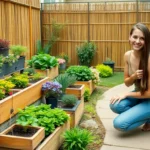Transform your outdoor space into a stunning desert oasis with creative cactus garden ideas that’ll make your neighbors stop and stare. We’ve discovered that cacti aren’t just low-maintenance plants – they’re architectural masterpieces that bring texture, color, and year-round beauty to any industry.
Whether you’re working with a sprawling backyard or a tiny balcony, we’ll show you how to create captivating cactus displays that thrive in various climates and conditions. From dramatic barrel cactus arrangements to delicate succulent combinations, these drought-tolerant gardens offer endless possibilities for both beginners and experienced gardeners.
Ready to embrace the beauty of desert landscaping? We’ve gathered the most inspiring cactus garden designs that’ll help you create a unique outdoor sanctuary while saving water and reducing maintenance time.
Create a Desert Oasis With Colorful Ceramic Pots
Ceramic containers transform ordinary cactus collections into stunning focal points that capture the vibrant spirit of desert landscapes. We’ve discovered that the right pottery can elevate your succulent display from simple plantings to artistic masterpieces.
Choose Vibrant Glazed Containers for Visual Impact
Glazed ceramic pots in bold turquoise, sunset orange, and deep terracotta create striking contrasts against spiky green cacti. We recommend selecting vessels with rich, saturated colors that complement your plants’ natural hues while adding personality to your space. Bright cobalt blue containers make golden barrel cacti pop dramatically, while coral pink pots enhance the silvery tones of prickly pear varieties.
Weather resistant glazes ensure your colorful containers maintain their brilliance through scorching summers and occasional frost. We suggest choosing pots with proper drainage holes, as ceramic’s natural porosity combined with adequate water flow prevents root rot in desert plants. Hand painted designs featuring geometric patterns or southwestern motifs add authentic desert flair to your cactus arrangements.
Mix Different Pot Sizes for Ever-changing Arrangements
Combining large statement planters with medium accent pieces and small detail containers creates visual rhythm throughout your desert garden space. We arrange towering ceramic urns filled with columnar cacti as dramatic anchors, then surround them with smaller pots containing clustering varieties like hen and chicks succulents. This layered approach mimics natural desert ecosystems where plants grow in diverse groupings.
Staggered heights using plant stands, decorative rocks, or varying pot elevations add dimension to flat surfaces like patios and balconies. We position our largest ceramic vessels at the back or center of displays, graduating down to petite containers along the edges for a cascading effect. Three different pot sizes typically provide the perfect balance without overwhelming smaller spaces or appearing too sparse in larger areas.
Design a Miniature Cactus Garden in Glass Terrariums
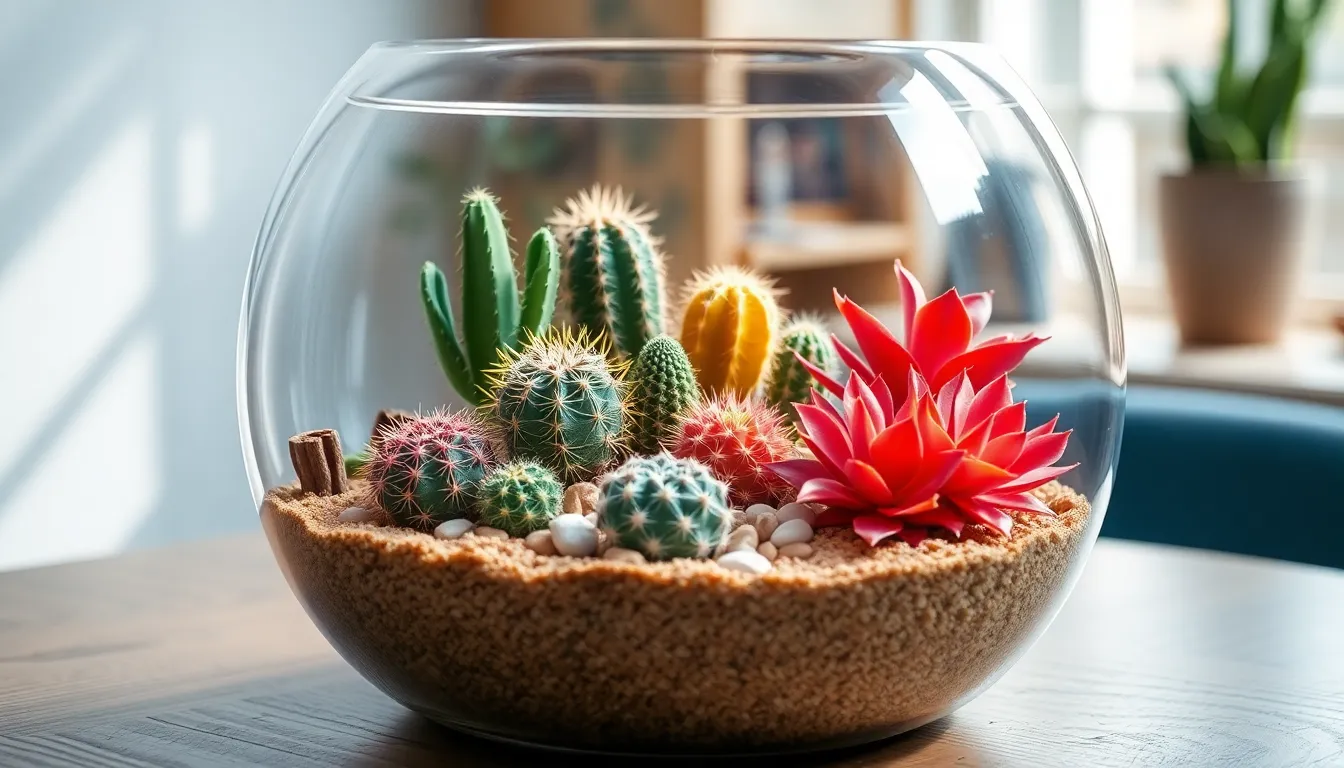
Creating indoor cactus gardens becomes effortless when we use glass terrariums to showcase our desert plants. These miniature landscapes bring the beauty of arid environments directly into our homes while maintaining the low maintenance appeal that makes cacti so popular.
Select Small Cacti Varieties for Enclosed Spaces
Choose varieties with similar care requirements to ensure all plants thrive together in your terrarium environment. Most cacti share comparable light and water needs, making them naturally compatible companions for enclosed glass gardens.
Focus on slow growing species that remain compact over time, preventing overcrowding in your limited terrarium space. Small barrel cacti, pincushion cacti, and mini columnar varieties work exceptionally well for these indoor displays.
Select different colored specimens to create visual interest throughout your miniature desert industry. We can combine blue-green barrel cacti with reddish prickly pears or golden torch cacti to achieve striking color contrasts.
Plant an odd number of cacti to create the most visually appealing arrangement in your terrarium. Three or five plants typically provide better balance than even numbered groupings.
Ensure wide-open terrarium designs that allow proper airflow around your cacti, as these desert plants require dry conditions to prevent root rot and fungal issues.
Layer Decorative Sand and Pebbles for Added Texture
Start with small rocks or pebbles at the bottom of your terrarium to create essential drainage for your cactus roots. This foundational layer prevents waterlogged soil while adding visual appeal to the overall design.
Add well-draining cactus soil as your second layer, ensuring it sits above the drainage rocks without mixing together. We recommend using commercially prepared cactus potting mix for optimal plant health.
Top with decorative sand or orchid bark to complete your layered terrarium industry and add textural interest to the surface. Colored sand creates beautiful patterns while bark provides natural organic appeal.
Sculpt the substrate layers to create ever-changing topography within your terrarium, mimicking natural desert terrain with gentle slopes and valleys.
Include hardscape elements like rocks between your cacti to add natural texture and create realistic desert scenes in miniature form.
Build a Raised Bed Cactus Garden for Outdoor Spaces
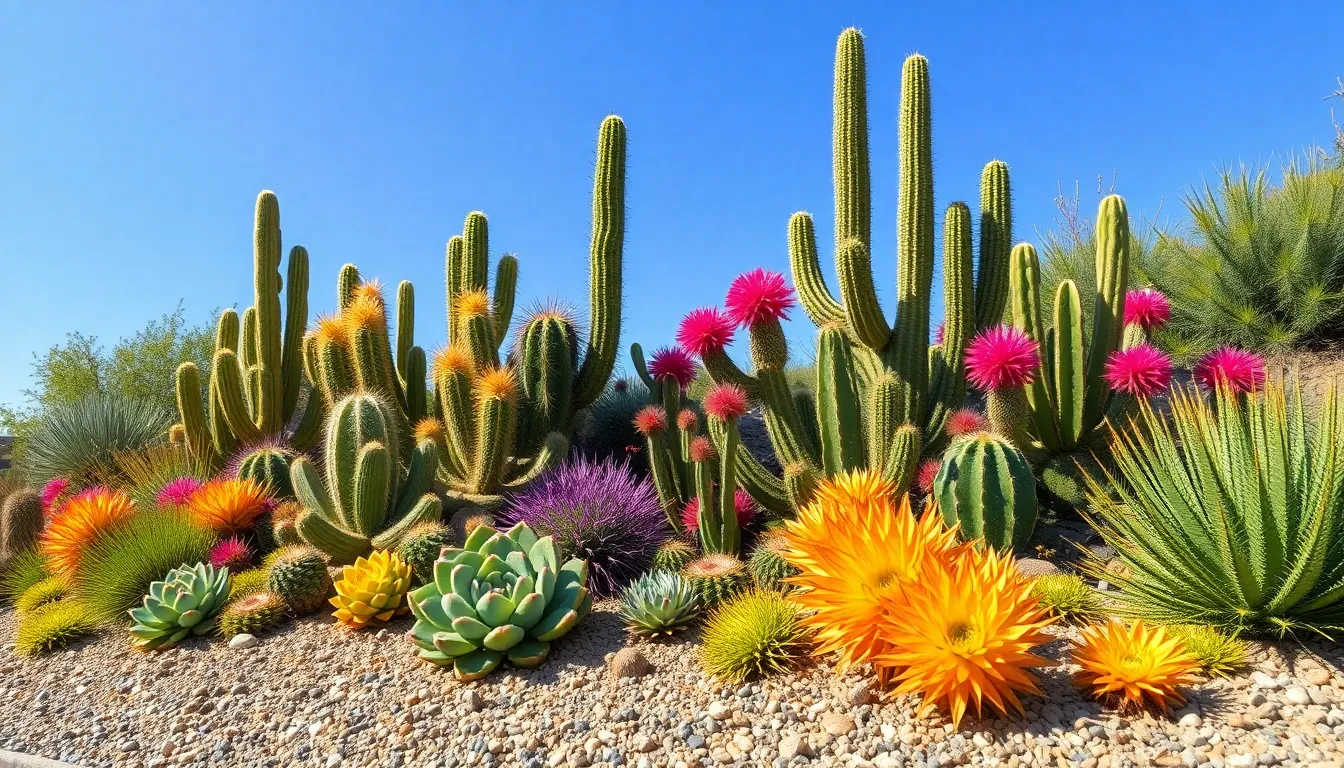
Building a raised bed cactus garden transforms ordinary outdoor areas into stunning desert showcases. This elevated approach gives us complete control over soil composition while creating an impressive architectural feature that enhances any industry design.
Ensure Proper Drainage With Gravel Base Layer
Creating a gravel base layer serves as the foundation for successful cactus cultivation in raised beds. We recommend installing a 4 to 6 inch layer of coarse gravel or crushed stone at the bottom of your raised bed before adding soil. This drainage system prevents water from pooling around cactus roots, which can quickly lead to fatal root rot.
Selecting the right materials makes all the difference for long term success. Pea gravel, decomposed granite, or small river rocks work exceptionally well as drainage materials. These allow water to flow freely while maintaining structural stability for the soil layers above.
Installing industry fabric over the gravel prevents soil migration while still allowing water to pass through. We’ve found that this simple addition keeps the drainage system functioning properly for years without clogging or soil contamination.
Incorporate Native Desert Plants for Authentic Appeal
Combining cacti with native desert plants creates landscapes that feel naturally cohesive and require minimal maintenance. We suggest selecting plants that share similar water and sunlight requirements to ensure all species thrive together harmoniously.
Cold hardy succulents like ocotillo, rainbow cactus, and chin cactus work beautifully in regions with temperature fluctuations. These varieties add diverse textures and seasonal interest while maintaining the authentic desert aesthetic throughout the year.
Grouping plants by height and growth patterns creates visual depth in raised bed designs. Place taller specimens like barrel cacti or columnar varieties toward the back, with spreading ground cover succulents filling the foreground spaces naturally.
Native grasses and flowering desert plants provide seasonal color changes that complement the year round structure of cacti. Consider adding desert willow, brittlebush, or ghost plant to introduce movement and softer textures that balance the bold architectural forms of larger cacti specimens.
Craft a Vertical Cactus Wall Garden

Transform any wall space into a stunning vertical desert display that maximizes your growing area while creating an eye-catching focal point.
Install Wall-Mounted Planters at Varying Heights
Mount planters at different elevations to create ever-changing visual interest across your wall surface. We recommend using containers of various sizes and shapes to add depth and prevent a monotonous appearance. Position larger planters at eye level while placing smaller ones above and below to establish natural flow patterns.
Stagger the placement by mounting some planters 6 inches higher or lower than others in the same row. This creates a cascading effect that draws the eye naturally across the entire display. Choose wall brackets that can support the weight of soil and plants when watered.
Space planters strategically with 12 to 18 inches between each container to allow proper airflow and prevent overcrowding. This spacing also gives each cactus room to grow while maintaining the overall composition’s balance.
Use Trailing and Upright Cacti for Visual Balance
Combine trailing varieties like Christmas cactus or trailing prickly pear with columnar species to achieve perfect visual harmony. We find this mixing technique creates natural depth while preventing the wall from appearing flat or one dimensional.
Position trailing cacti in upper planters where their cascading growth can spill downward naturally. Place these dramatic spillers above upright varieties to create layers that mimic desert cliff formations.
Select upright cacti such as columnar varieties for middle and lower positions where their architectural forms can anchor the display. These vertical elements provide structure while the trailing plants add softness and movement to the overall design.
Arrange plants by growth habits to ensure each species has adequate space to develop its natural form. We recommend grouping similar care requirements together to simplify watering and maintenance routines.
Establish a Rock Garden With Embedded Cacti
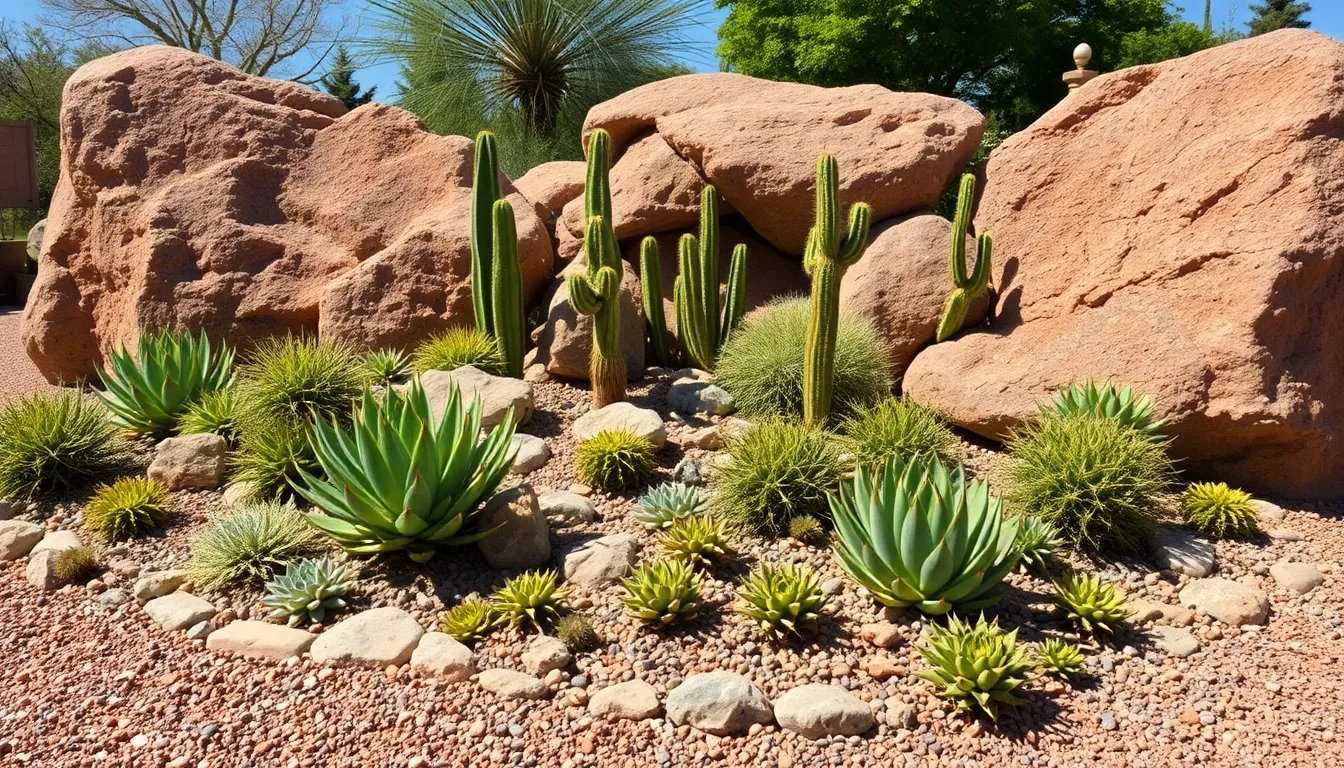
Rock gardens with embedded cacti create stunning, low-maintenance landscapes that thrive in challenging conditions. This water-efficient approach combines the architectural beauty of large stones with the sculptural appeal of desert plants.
Position Large Boulders as Natural Focal Points
Large boulders serve as the foundation for our rock garden design, creating visual anchors that guide the eye through the industry. We strategically place these natural stones to establish focal points while providing essential benefits for our cacti plantings.
Temperature regulation becomes crucial when boulders help moderate soil conditions around our plants. These massive stones absorb heat during the day and release it slowly at night, creating microclimates that protect sensitive cacti from temperature extremes.
Moisture retention improves significantly when we position boulders to channel rainwater toward planting areas. The stones create natural collection points that direct precious water to cactus root zones while preventing erosion on sloped terrain.
Visual interest develops naturally when we vary boulder sizes and positions throughout the garden space. Larger stones anchor the design while medium-sized rocks create transition zones between different planting areas, establishing a cohesive desert aesthetic.
Structural stability emerges from properly positioned boulders that prevent soil shifting and erosion. We ensure these permanent fixtures remain stable by burying at least one-third of each boulder below ground level for maximum security.
Fill Gaps With Drought-Tolerant Succulent Varieties
Spaces between our positioned boulders become opportunities for creating diverse plant communities that complement our embedded cacti. We select succulents that share similar water requirements while adding texture and seasonal color to the garden.
Sedums offer excellent ground cover options that spread naturally between rocks and suppress weed growth. Popular varieties like Sedum spurium and Sedum kamtschaticum create dense mats of colorful foliage that require minimal water once established.
Aloes provide dramatic architectural elements with their rosette forms and occasional spectacular flower spikes. Species like Aloe vera and Aloe brevifolia adapt well to rock garden conditions and complement larger cacti specimens beautifully.
Agaves create bold focal points with their geometric leaf patterns and impressive size potential. Century plants and smaller varieties like Agave parryi add sculptural interest while maintaining the desert theme throughout our design.
Barrel cacti nestled between boulders create natural-looking arrangements that mimic desert environments. We position these rounded specimens, including Ferocactus and Echinocactus varieties, where they receive optimal drainage and sun exposure.
Prickly pear cacti spread horizontally to fill wider gaps while producing colorful blooms and edible fruits. These versatile plants, including Opuntia ficus-indica and Opuntia humifusa, adapt to various climate conditions and soil types.
Flowering cacti like Echinopsis hybrids and Rebutia species add seasonal bursts of vibrant color to our rock garden palette. These compact plants produce stunning blooms in spring and summer, creating dramatic contrasts against neutral stone backgrounds.
We complete our design by spreading stone mulch or gravel throughout the garden to minimize weeds and retain soil moisture, creating a cohesive, water-efficient industry that thrives with minimal maintenance.
Transform Old Containers Into Unique Cactus Planters
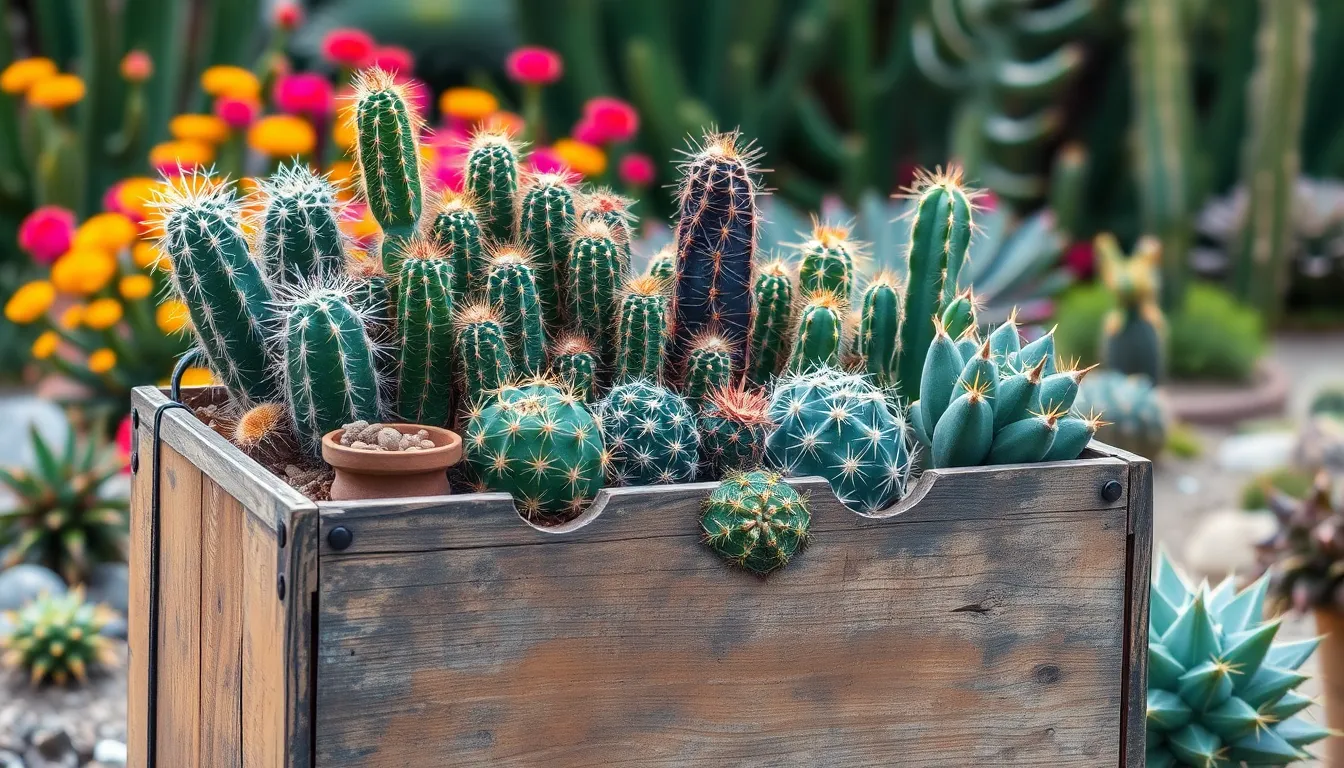
We’ve discovered that repurposing everyday containers creates charming, personalized cactus displays that add character to any desert garden arrangement.
Repurpose Vintage Tins and Wooden Boxes
Vintage coffee tins, tea containers, and weathered wooden boxes make exceptional cactus planters that bring nostalgic charm to our desert landscapes. These containers offer unique textures and patinas that complement the architectural forms of cacti beautifully. We recommend selecting containers with interesting graphics, aged finishes, or rustic wood grain patterns that enhance the natural beauty of our cactus collections.
Old olive oil tins work particularly well for medium-sized barrel cacti, while smaller tea tins perfectly accommodate pincushion cacti or small clustering varieties. Wooden wine crates create stunning displays when filled with multiple small cacti arranged at different heights. We’ve found that metal containers develop beautiful rust patinas over time, adding authentic desert character to our garden arrangements.
Galvanized buckets, vintage toolboxes, and antique watering cans also serve as conversation-starting planters that reflect our personal style. These containers tell stories while providing practical homes for our cactus collections.
Add Drainage Holes to Prevent Water Accumulation
Drilling proper drainage holes transforms any container into a suitable cactus home, preventing the root rot that destroys desert plants in waterlogged conditions. We use a drill with metal or wood bits to create multiple quarter-inch holes spaced evenly across the bottom of each container. Metal containers require slower drilling speeds to prevent cracking, while wooden boxes need careful pilot holes to avoid splitting.
We recommend creating at least three drainage holes for containers under 6 inches wide, and five to seven holes for larger planters. Placing a coffee filter or small piece of mesh over each hole prevents soil from washing out while maintaining proper water flow. This simple modification ensures our repurposed containers provide the excellent drainage that cacti require to thrive.
For containers without removable bottoms, we position them on platforms or plant stands that allow excess water to flow away completely. This elevation technique works especially well for vintage containers we want to preserve in their original condition.
Create Themed Cactus Gardens With Decorative Elements
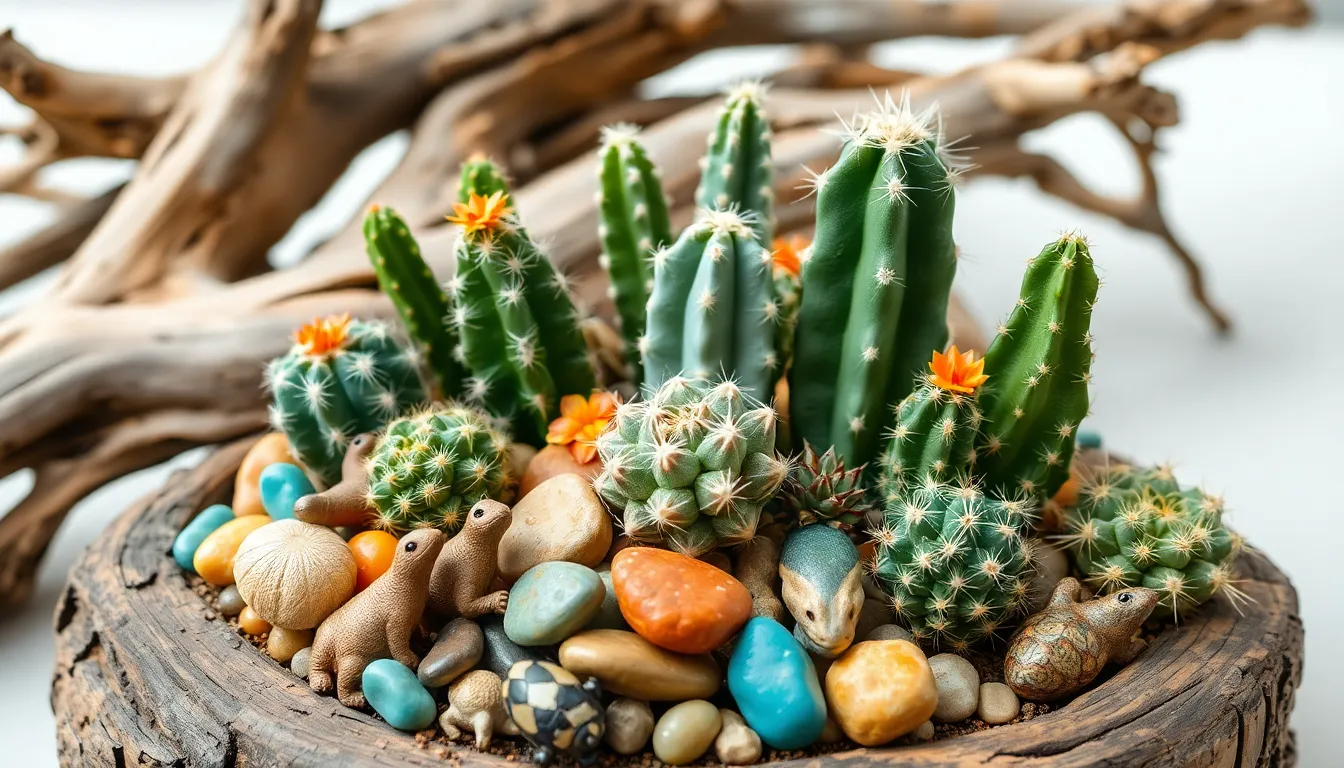
Taking our cactus garden design beyond basic plantings opens endless possibilities for personalization and visual storytelling. Strategic decorative elements transform ordinary cactus displays into captivating themed landscapes that reflect our unique style preferences.
Add Miniature Desert Figurines and Colored Stones
Desert figurines bring whimsical charm to cactus arrangements while creating focal points that draw visitors deeper into our garden story. Small animal sculptures like lizards, roadrunners, or desert tortoises nestle perfectly between cactus clusters without overwhelming the natural beauty of our plants.
Colored stones elevate the visual impact of our cactus gardens through strategic placement and pattern creation. Turquoise pebbles complement the silvery tones of barrel cacti, while sunset orange stones create stunning contrasts against deep green prickly pears. We can arrange these colorful elements in spirals around individual plants or create bordered pathways that guide the eye through our desert industry.
Pattern arrangements using colored stones add professional polish to our themed gardens. Alternating bands of white and gray pebbles create clean geometric lines, while mixed earth tones in random patterns mimic natural desert floors. These stone accents also serve practical purposes by retaining soil moisture and preventing weed growth around our precious cacti.
Incorporate Driftwood and Natural Branch Accents
Weathered driftwood pieces create authentic desert ambiance that connects our cactus gardens to their natural southwestern origins. Large driftwood sections work beautifully as natural borders between different cactus groupings, while smaller pieces can frame individual showcase plants or create rustic pathways through our garden space.
Natural branch arrangements provide structural support for our garden design while maintaining the organic desert aesthetic we’re cultivating. Twisted mesquite branches or bleached oak limbs can serve as natural trellises for climbing cacti like night blooming cereus, creating vertical interest without artificial materials.
Strategic placement of these natural elements enhances the storytelling aspect of our themed gardens. We can position larger driftwood pieces to create natural seating areas where visitors can appreciate our cactus collections up close, or use branching wood to create natural divisions between different themed sections of our garden space.
Develop a Low-Maintenance Indoor Cactus Display

Creating an indoor cactus display brings the beauty of desert landscapes inside while maintaining the practical benefits of low maintenance gardening. We’ll focus on strategic plant placement and automated care systems to maximize success with minimal effort.
Group Cacti by Similar Light Requirements
Organizing your cacti by their lighting needs ensures each plant thrives without constant repositioning. High light varieties like the Bunny Ears Cactus (Opuntia microdasys) and Star Cactus (Astrophytum asteria) perform best when placed in south facing windows where they receive ample direct sunlight throughout the day.
Position medium to low light tolerant species in areas with filtered or indirect illumination. Blue Hens and Chicks (Echeveria glauca) adapts well to spaces with less intense lighting conditions, making it perfect for interior locations away from direct window exposure.
Create distinct lighting zones throughout your home to accommodate different cactus species simultaneously. East facing windows provide gentle morning light for moderate light requirements, while north facing locations work well for shade tolerant varieties that still need some natural illumination.
Use Self-Watering Systems for Consistent Care
Self watering planters eliminate the guesswork from cactus care by allowing plants to draw moisture as needed. These systems maintain optimal soil moisture levels without the risk of overwatering that commonly kills indoor cacti, making them ideal for busy homeowners or frequent travelers.
Install reservoir based watering systems that provide consistent hydration over extended periods. The built in water storage allows cacti to access moisture gradually through capillary action, mimicking their natural ability to absorb water slowly from desert soils.
Monitor water levels in self watering containers monthly to maintain proper function. Most systems include water level indicators that show when refilling is necessary, typically every 2-4 weeks depending on plant size and environmental conditions.
Combine self watering technology with proper drainage materials to prevent root rot. Layer pebbles or activated charcoal in the bottom of containers to create separation between the water reservoir and soil, ensuring roots stay healthy while accessing needed moisture.
Plan a Xeriscape Cactus Garden for Water Conservation
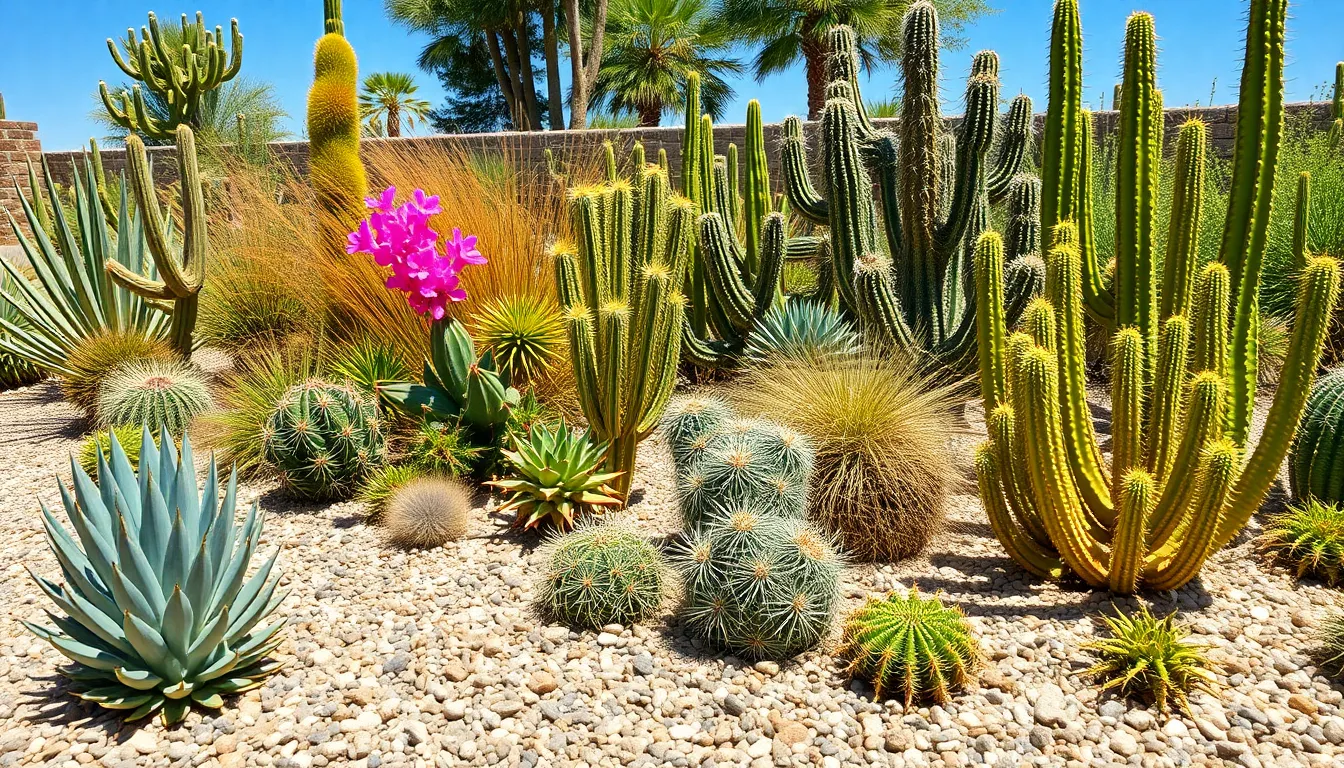
Creating a water-wise cactus garden transforms outdoor spaces into sustainable desert landscapes that thrive with minimal irrigation. We’ll guide you through essential steps to establish a xeriscape design that conserves water while creating stunning visual impact.
Select Native Cacti Species for Your Climate Zone
Choosing native cacti species ensures your garden flourishes with minimal water requirements while supporting local ecosystems. Mexican Fence Post and San Pedro Cactus serve as exceptional focal points that naturally adapt to regional climate conditions. These statement plants establish strong architectural elements that anchor your garden design.
Research your exact hardiness zone to identify cacti species that have evolved in your area’s temperature ranges and rainfall patterns. Native varieties require less supplemental watering because they’ve adapted to local soil conditions and seasonal weather cycles. Contact local botanical gardens or extension offices to discover which indigenous species will perform best in your exact microclimate.
Group cacti with similar water and light requirements to create maintenance zones throughout your garden space. This strategic placement reduces overall irrigation needs while ensuring each plant receives appropriate care. Consider the mature size of each species to prevent overcrowding as your garden establishes over time.
Mulch With Decorative Gravel to Retain Moisture
Applying decorative gravel mulch creates an effective moisture retention system while adding aesthetic appeal to your xeriscape design. Gravel allows rapid drainage of excess water while maintaining soil moisture levels during dry periods. This dual function reduces watering frequency and prevents root rot conditions that damage cacti.
Select gravel sizes between 1/4 inch and 1/2 inch for optimal water management and visual texture. Larger decorative stones create bold focal points while smaller pebbles fill gaps between plants seamlessly. Layer gravel 2 to 3 inches deep around plant bases to maximize moisture retention benefits.
Combine gravel mulching with proper soil preparation using a mixture of native soil, pumice, compost, and specialized amendments. This foundation blend provides necessary drainage while delivering essential nutrients for healthy plant development. Smooth pebbles and sand elements enhance the minimalist aesthetic while supporting the garden’s water conservation goals.
Design Seasonal Cactus Arrangements
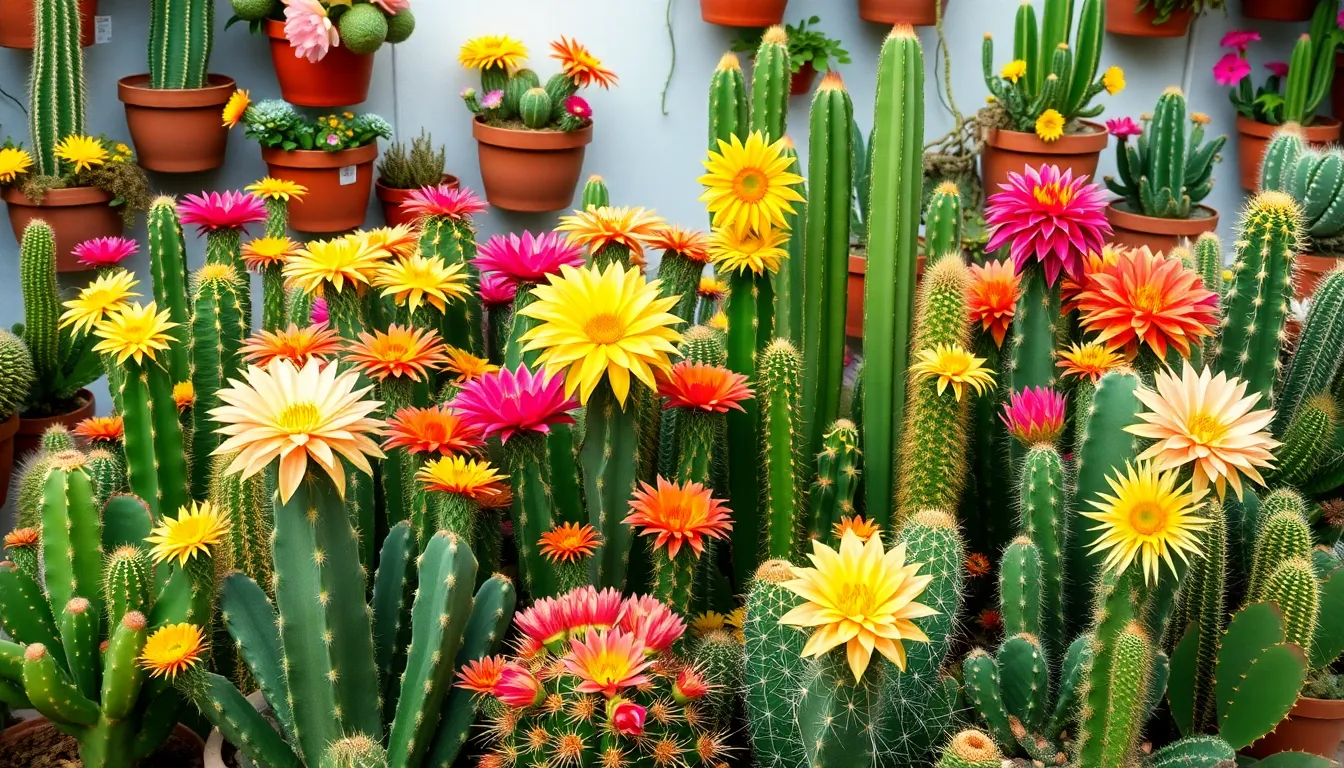
We can transform our cactus gardens throughout the year by adjusting pot layouts, plant groupings, and decorative elements to reflect each season’s unique character. This flexible approach allows us to personalize our displays and create fresh visual interest as seasons change.
Choose Blooming Varieties for Spring Color
Spring calls for selecting cacti that produce vibrant blooms to enhance our garden’s seasonal appeal. Echinopsis, Mammillaria, and Parodia species offer stunning flowers in bright pinks, yellows, and oranges that create eye-catching focal points in our arrangements.
We should strategically place these flowering varieties where they’ll receive ample sunlight to maximize their bloom potential. Mixing blooming cacti with evergreen succulents creates ever-changing displays that celebrate spring’s renewal while maintaining year-round structure.
Popular spring blooming cacti include:
- Echinopsis species (Easter Lily Cactus) with large, trumpet-shaped flowers
- Mammillaria varieties producing small, colorful crown blooms
- Parodia cacti offering bright yellow and orange flowers
Rotate Plants Based on Growth Patterns
Rotating and repositioning our cacti prevents overcrowding while accommodating different growth habits throughout the seasons. Tall, columnar varieties like Pachycereus or Cereus work best at the back or center of arrangements to avoid shading smaller plants.
We can place spreading, clump-forming species such as Opuntia or Gymnocalycium along edges or in foreground positions where their growth patterns won’t interfere with other plants. Regular rotation ensures balanced light exposure and maintains our arrangement’s visual appeal as plants mature.
Strategic placement by growth type:
| Growth Pattern | Best Placement | Examples |
|---|---|---|
| Tall, columnar | Back/center positions | Pachycereus, Cereus |
| Spreading, clumping | Edges/foreground | Opuntia, Gymnocalycium |
| Compact, globe-shaped | Middle sections | Echinocactus, Ferocactus |
Incorporating vertical plantings in stacked pots or wall-mounted planters maximizes our space while adding modern touches to seasonal displays. This approach works particularly well when transitioning between seasons, allowing us to easily swap out decorative elements like holiday lights or seasonal ornaments.
Conclusion
Creating stunning cactus gardens offers endless possibilities for transforming any space into a captivating desert sanctuary. We’ve explored various approaches from colorful container displays to sophisticated xeriscape designs that celebrate both beauty and sustainability.
The versatility of cacti allows us to experiment with different styles while maintaining our commitment to water conservation and low-maintenance gardening. Whether we’re designing intimate indoor arrangements or expansive outdoor landscapes these resilient plants reward our creativity with year-round visual interest.
Now it’s time to put these ideas into action and start building the cactus garden that perfectly suits our space and lifestyle. With proper planning and the right plant selections we can create a thriving desert oasis that brings joy for years to come.
Frequently Asked Questions
What are the main benefits of creating a cactus garden?
Cactus gardens offer numerous advantages including low maintenance requirements, drought tolerance, and year-round visual appeal. They’re perfect for water conservation, require minimal care once established, and provide unique architectural elements with their diverse shapes and textures. These gardens work well in various climates and are ideal for both beginners and experienced gardeners seeking sustainable landscaping solutions.
How do I choose the right containers for my cactus collection?
Select weather-resistant ceramic pots with proper drainage holes to prevent root rot. Bold, glazed containers create striking visual contrasts with cacti. Mix different pot sizes to add visual rhythm and dimension to your display. Ensure the pots can withstand your local climate conditions and choose colors that complement your overall garden design aesthetic.
What should I know about creating cactus terrariums?
Choose small cactus varieties with similar care requirements and ensure proper airflow to prevent root rot. Layer decorative sand and pebbles for texture, and include hardscape elements to mimic natural desert scenes. Select glass containers with adequate ventilation and avoid closed systems that trap moisture, which can harm your cacti.
How do I build a successful raised bed cactus garden?
Focus on proper soil composition and excellent drainage using a well-draining cactus mix. Incorporate native desert plants for minimal maintenance and add native grasses and flowering plants for seasonal color. Ensure the raised bed is at least 12 inches deep and consider the mature size of your cacti when planning spacing.
What’s involved in creating a vertical cactus wall garden?
Use wall-mounted planters at varying heights and combine trailing and upright cacti for visual balance. Ensure proper drainage in each planter and consider weight distribution on your wall structure. Group plants with similar light and water requirements together, and provide adequate support for the mounting system to handle the weight safely.
How can I incorporate cacti into rock gardens effectively?
Use large boulders for temperature regulation and moisture retention, then fill gaps with drought-tolerant succulents. Position rocks to create natural-looking arrangements while providing microclimates for your plants. Ensure proper drainage around rock placements and select cacti that complement the scale and color of your chosen stones.
What are the key elements of a successful xeriscape cactus garden?
Select native cacti species adapted to your local climate conditions to minimize water requirements. Group plants with similar water and light needs into maintenance zones. Apply decorative gravel mulch (1/4 to 1/2 inch) to retain moisture and enhance aesthetics. Combine proper soil preparation with strategic plant placement for optimal water conservation.
How do I create effective seasonal cactus arrangements?
Adjust pot layouts and plant groupings to reflect each season’s character, featuring blooming cacti like Echinopsis and Mammillaria for spring displays. Plan strategic placement based on growth patterns to prevent overcrowding. Incorporate vertical plantings in stacked pots or wall-mounted planters to maximize space and add modern touches to seasonal displays.
What’s the best approach for low-maintenance indoor cactus displays?
Group cacti by similar light requirements and create distinct lighting zones throughout your home. Use self-watering systems to maintain optimal soil moisture levels while monitoring water levels regularly. Combine automated care technology with proper drainage materials to prevent root rot and ensure your indoor cacti thrive with minimal daily attention.
How can I repurpose old containers for unique cactus planters?
Transform old containers by adding proper drainage holes and using weather-resistant materials. Embrace the charm of repurposed items like vintage buckets, boots, or decorative vessels. Ensure containers are large enough for root development and apply protective coatings if needed to extend their lifespan in outdoor conditions.






